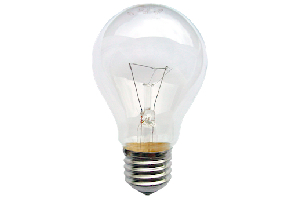 Say goodbye to an old friend. Photo by WikiMedia.
Say goodbye to an old friend. Photo by WikiMedia.
You know which light bulb I mean. It’s the one you’ve burned your hands on when trying to unscrew it too soon after it’s been turned off. It’s the one you put in the lamp in your living room to read by in your comfortable chair; the one you use to light the stairways at night. It’s the 100-watt incandescent that uses practically the same technology put together by Thomas Edison in 1879. It’s a metal filament inside a glass vacuum that gives off light and heat when exposed to an electric current. Say goodbye. It’s out of our hands. It’s a goner. I’m guessing it won’t go quietly.
It’s a little late to say goodbye in California, where 100-watt incandescents have been effectively banned since January 1. The rest of the country will catch up to us next year, when the popular light bulb will be banned everywhere in the United States. It is not really an outright ban that is clearing the shelves of 100-watt incandescents in 2012, followed by the 75-watt bulb in 2013, and the 60- and 40-watt bulbs beginning in 2014. What’s killing the familiar bulb is an act of Congress that mandated efficiency standards that incandescents cannot meet: the Energy Independence and Security Act (EISA) of 2007. As the standard for watts per lumen (a measure of light output) become higher and higher, the familiar bulbs will begin disappearing from store shelves. It will be illegal to manufacture the less efficient bulbs in the United States or import them from abroad. A few special use incandescents will still be allowed, for example 3-way bulbs and appliance bulbs.
The most popular incandescents will gradually give way to more efficient halogen, fluorescent and compact fluorescent lights, and solid state lighting (SSL) devices like light emitting diodes (LED). The reduction in total energy use and green house gas emissions in the United States will be dramatic. According to an analysis by the American Council for an Energy Efficient Economy (ACEEE) the efficient light bulb provisions of the EISA will reduce national energy use by 60 terra-watt hours (terra equals trillion) of energy and reduce national emissions by 12 million metric tons of carbon by the year 2020.
